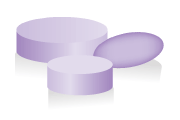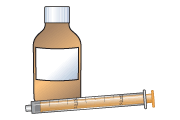Lacosamide for preventing seizures
This leaflet is for parents and carers about how to use this medicine in children. Our information may differ from that provided by the manufacturers, because their information usually relates to adults. Read this leaflet carefully. Keep it somewhere safe so that you can read it again.
Do not stop giving Lacosamide suddenly, as your child may have more seizures.
Name of medicine
Lacosamide
Brand name: Vimpat
Why is it important for my child to take Lacosamide?
It is important that your child takes lacosamide regularly so that they have fewer seizures.
What is Lacosamide available as?
- Tablets: 50 mg, 100 mg, 150 mg, 200 mg
- Liquid medicine: 10 mg in 1 mL; contains aspartame
When should I give Lacosamide
Lacosamide may be given once or twice a day.
- Once a day: This is usually in the evening.
- Twice a day: This should be once in the morning and once in the evening. Ideally, these times are 10–12 hours apart, for example sometime between 7am and 8am and between 7pm and 8pm.
How much should I give?
Your doctor will work out the amount of Lacosamide (the dose) that is right for your child. The dose will be shown on the medicine label.
Your doctor may suggest that your child starts with a low dose. They may then increase the dose as your child gets used to the medicine and depending on how they respond to it. Your doctor will explain what to do. If you are not sure how much to give, check with your doctor, nurse or pharmacist.
It is important that you follow your doctor’s instructions about how much to give.
How should I give Lacosamide?

Tablets
- Tablets should be swallowed with a glass of water, squash or juice. Your child should not chew the tablet.

Liquid medicine
- Shake the medicine well.
- Measure out the right amount using an oral syringe or a medicine spoon. You can get these from your pharmacist. Do not use a kitchen teaspoon as it will not give the right amount.
When should the medicine start working?
It will take a few weeks for Lacosamide to work properly, so your child may still have seizures during this time. This is because the amount of medicine has to be increased slowly. Continue to give the medicine as you have been told to by your doctor.
What if my child is sick (vomits)?
- If your child is sick less than 30 minutes after having a dose of Lacosamide, give them the same dose again.
- If your child is sick more than 30 minutes after having a dose of Lacosamide, do not give them another dose. Wait until the next normal dose.
If your child is sick again, seek advice from your family doctor, nurse, pharmacist, or hospital. They will decide what to do based on your child’s condition and the specific medicine involved.
What if I forget to give it?
If you usually give it twice a day: If you remember up to 4 hours after you should have given a dose, give your child the missed dose. For example, if you usually give a dose at about 7am, you can give the missed dose at any time up to 11am. If you remember after that time, do not give the missed dose. Give the next dose as usual.
If you are giving it once a day in the evening: If you remember before your child goes to sleep, give them the missed dose. If you remember after this time, you do not need to wake your child up to give the missed dose. You can give it in the morning. There must be at least 4 hours before the next usual evening dose.
Never give a double dose of Lacosamide.
What if I give too much?
If you think you may have given your child too much Lacosamide, contact your doctor or local NHS services (details at end of leaflet). Have the medicine or packaging with you if you telephone for advice.
Are there any possible side effects?
We use medicines to make our children better, but sometimes they have other effects that we don’t want (side effects).
Side effects you must do something about
If after taking Lacosamide for a few days or weeks your child gets an itchy rash over their whole body, contact your doctor, as your child may be allergic to the medicine.
Other side-effects you need to know about
Your child may get these side-effects when they first start taking Lacosamide but they will usually settle down within about 2 weeks as their body gets used to the medicine. Continue to give Lacosamide to your child as your doctor has told you to. If any of these side-effects continue, contact your doctor.
Your child may feel drowsy or sleepy, have headaches, feel dizzy or have mild tremors (shakiness).
Your child may feel sick (nausea) or be sick (vomit).
There may sometimes be other side effects that are not listed above. If you notice anything unusual and are concerned, contact your doctor. You can report any suspected side effects to a UK safety scheme at mhra.gov.uk/yellowcard
Can other medicines be given at the same time as Lacosamide?
- You can give your child medicines that contain paracetamol or ibuprofen, unless your doctor has told you not to.
Check with your doctor or pharmacist before giving any other medicines to your child. This includes herbal and complementary medicines.
Epilepsy and pregnancy
- Pregnancy presents a risk to both the mother with epilepsy and her unborn baby. If your daughter has sex, it is essential that she uses adequate contraception to prevent an unplanned pregnancy.
- If your daughter thinks that she may be pregnant, it is important that she sees your family doctor as soon as possible. She should keep taking her medicine until she sees her doctor.
Lacosamide and pregnancy
- Doctors don’t yet know whether lacosamide can harm an unborn baby.
- The oral contraceptive pill can be used safely by women or girls who are taking lacosamide.
General advice about medicines
Advice about medicines for seizures
- If your doctor decides to stop a particular medicine, they will discuss this with you. They will usually reduce the dose bit by bit.
- It is best that your child always has the same brand of each medicine, as there may be differences between brands. Keep a record of which medicines your child has.
- Try to give medicines at about the same times each day, to help you remember.
- Only give this medicine to your child. Never give it to anyone else, even if their condition appears to be the same, as this could do harm.
- Make sure that you always have enough medicine. Order a new prescription at least 2 weeks before you will run out.
- Make sure that the medicines you have at home have not reached the ‘best before’ or ‘use by’ date on the packaging. Give old medicines to your pharmacist to dispose of.
Do not suddenly stop giving any medicines for seizures to your child. If you are worried, contact your doctor but carry on giving the medicine to your child as usual.
If your child seems to have more seizures than usual, contact your doctor or epilepsy nurse.
Do not change the dose of any medicine without talking to your doctor first.
If you think someone else may have taken the medicine by accident, contact your doctor straight away.
Where should I keep this medicine?
- Keep the medicine in a cupboard, away from heat and direct sunlight.
- It does not need to be kept in the fridge.
- Make sure that children cannot see or reach the medicine.
- Keep the medicine in the container it came in.
Who to contact for more information?
Your child’s doctor, pharmacist or nurse will be able to give you more information about Lacosamide and about other medicines used to treat epilepsy.
England: NHS 111
Tel 111
www.nhs.ukScotland: NHS 24
Tel 111
www.nhs24.scotNorthern Ireland: NI Direct
Wales: NHS 111 Wales
Tel 111
www.111.wales.nhs.ukEpilepsy Action
0808 800 5050
www.epilepsy.org.ukEpilepsy Society
01494 601 400
epilepsysociety.org.ukYoung Epilepsy
01342 831342
www.youngepilepsy.org.ukCopyright disclaimer
Version [2]. © NPPG, RCPCH and WellChild, all rights reserved. Review by September 2017.
The primary source for the information in this leaflet is the British National Formulary for Children. For details on any other sources used for this leaflet, please contact us through our website, www.medicinesforchildren.org.uk.
We take great care to make sure that the information in this leaflet is correct and up-to-date. However, medicines can be used in different ways for different patients. It is important that you ask the advice of your doctor or pharmacist if you are not sure about something. This leaflet is about the use of these medicines in the UK, and may not apply to other countries. The Royal College of Paediatrics and Child Health (RCPCH), the Neonatal and Paediatric Pharmacists Group (NPPG), WellChild and the contributors and editors cannot be held responsible for the accuracy of information, omissions of information, or any actions that may be taken as a consequence of reading this leaflet.
